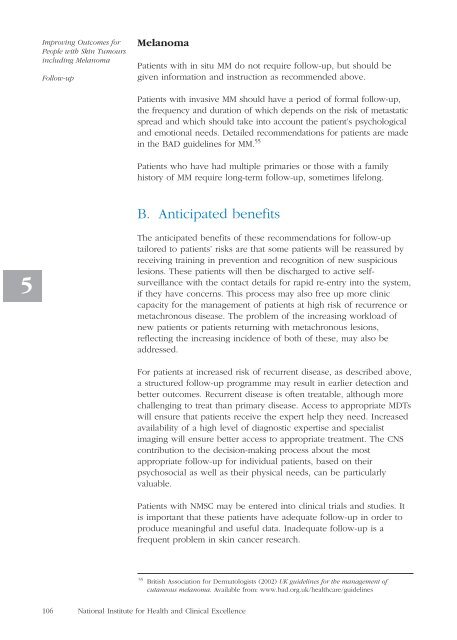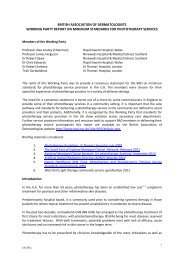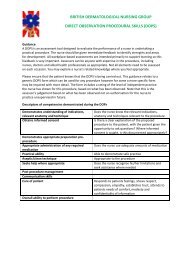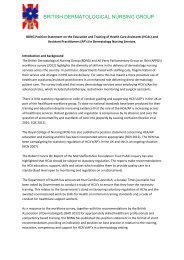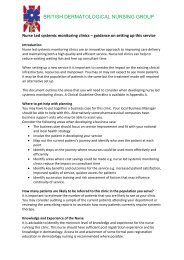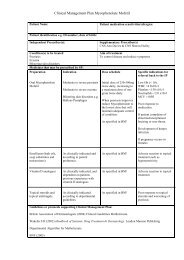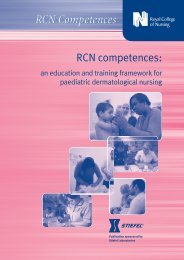Improving outcomes for people with skin tumours including melanoma
Improving outcomes for people with skin tumours including melanoma
Improving outcomes for people with skin tumours including melanoma
Create successful ePaper yourself
Turn your PDF publications into a flip-book with our unique Google optimized e-Paper software.
<strong>Improving</strong> Outcomes <strong>for</strong><br />
People <strong>with</strong> Skin Tumours<br />
<strong>including</strong> Melanoma<br />
Follow-up<br />
Melanoma<br />
Patients <strong>with</strong> in situ MM do not require follow-up, but should be<br />
given in<strong>for</strong>mation and instruction as recommended above.<br />
Patients <strong>with</strong> invasive MM should have a period of <strong>for</strong>mal follow-up,<br />
the frequency and duration of which depends on the risk of metastatic<br />
spread and which should take into account the patient’s psychological<br />
and emotional needs. Detailed recommendations <strong>for</strong> patients are made<br />
in the BAD guidelines <strong>for</strong> MM. 55<br />
Patients who have had multiple primaries or those <strong>with</strong> a family<br />
history of MM require long-term follow-up, sometimes lifelong.<br />
B. Anticipated benefits<br />
5<br />
The anticipated benefits of these recommendations <strong>for</strong> follow-up<br />
tailored to patients’ risks are that some patients will be reassured by<br />
receiving training in prevention and recognition of new suspicious<br />
lesions. These patients will then be discharged to active selfsurveillance<br />
<strong>with</strong> the contact details <strong>for</strong> rapid re-entry into the system,<br />
if they have concerns. This process may also free up more clinic<br />
capacity <strong>for</strong> the management of patients at high risk of recurrence or<br />
metachronous disease. The problem of the increasing workload of<br />
new patients or patients returning <strong>with</strong> metachronous lesions,<br />
reflecting the increasing incidence of both of these, may also be<br />
addressed.<br />
For patients at increased risk of recurrent disease, as described above,<br />
a structured follow-up programme may result in earlier detection and<br />
better <strong>outcomes</strong>. Recurrent disease is often treatable, although more<br />
challenging to treat than primary disease. Access to appropriate MDTs<br />
will ensure that patients receive the expert help they need. Increased<br />
availability of a high level of diagnostic expertise and specialist<br />
imaging will ensure better access to appropriate treatment. The CNS<br />
contribution to the decision-making process about the most<br />
appropriate follow-up <strong>for</strong> individual patients, based on their<br />
psychosocial as well as their physical needs, can be particularly<br />
valuable.<br />
Patients <strong>with</strong> NMSC may be entered into clinical trials and studies. It<br />
is important that these patients have adequate follow-up in order to<br />
produce meaningful and useful data. Inadequate follow-up is a<br />
frequent problem in <strong>skin</strong> cancer research.<br />
55 British Association <strong>for</strong> Dermatologists (2002) UK guidelines <strong>for</strong> the management of<br />
cutaneous <strong>melanoma</strong>. Available from: www.bad.org.uk/healthcare/guidelines<br />
106<br />
National Institute <strong>for</strong> Health and Clinical Excellence


